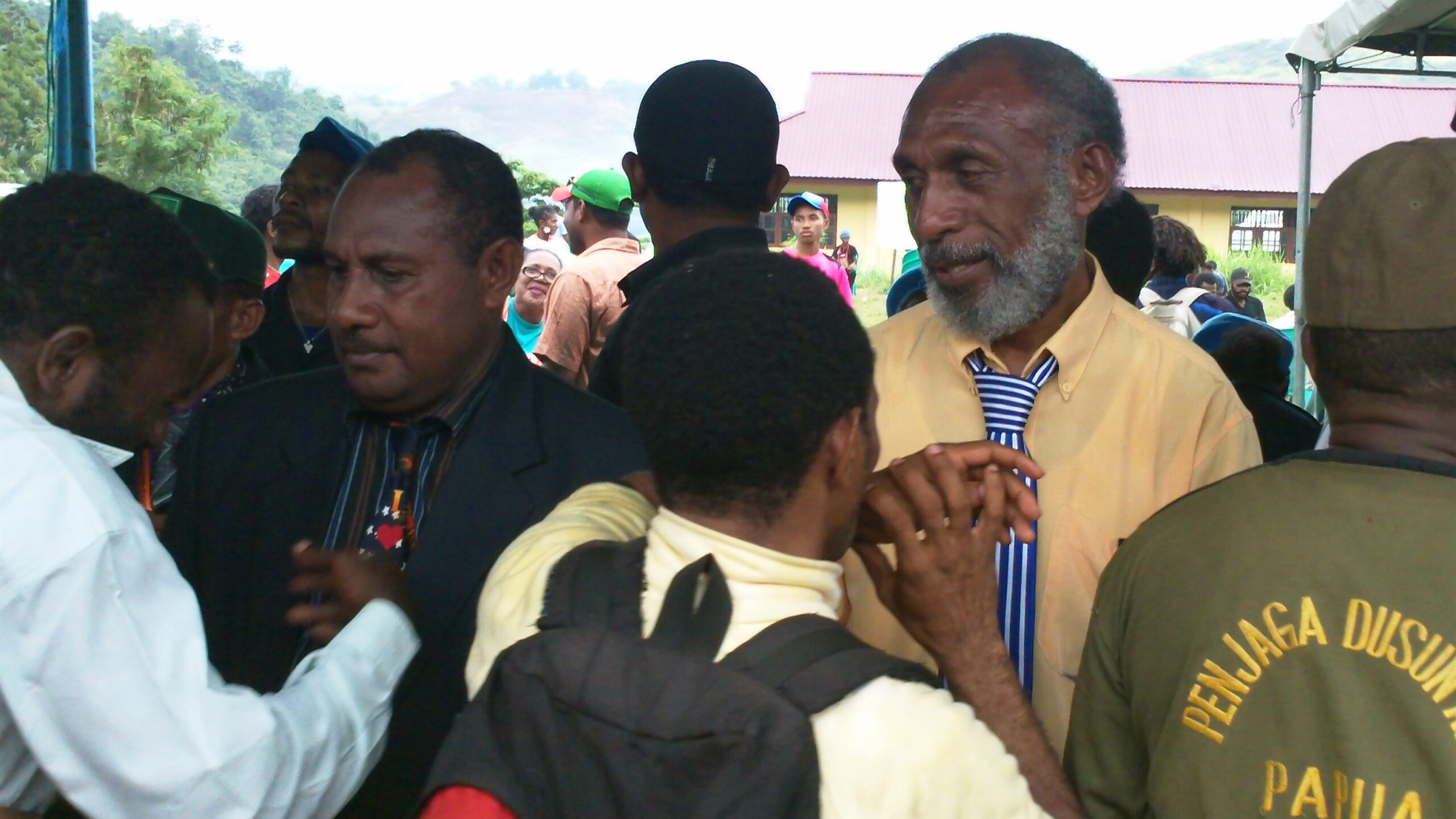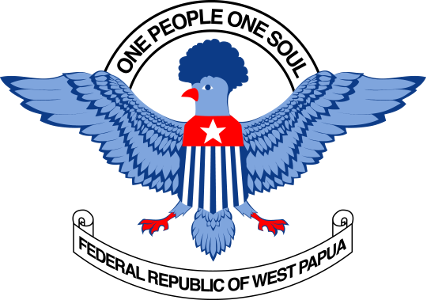
Prime Minister Edison Waromi (left) alongside President Yaboisembut, at the conclusion of the 3rd Congress in 2011, moments before they were arrested.
EDISON WAROMI: Story of an individual, Biography of a Melanesian nation
A video of 25 slides prepared by Louise Byrne (Globalism Institute, RMIT University) for her presentation to the Australian Anthropological Society Conference, Australian National University in Canberra, on 8 November 2013 (On Being Human: Experiencing Danger, Risk and Trauma). Later her presentation was reconstructed as a video with voice-over and transcript.
Story of an individual, Biography of a Melanesian nation (Video, 15 min)
http://youtu.be/cK8P9DYKitI
Transcript of presentation
Slide 1. My subject is Edison Waromi, Prime Minister of the Federal Republic of West Papua, which means we are examining the trauma embodied by Papuan academics and students, and the risks they take in the name of peace and justice after years of brutal Indonesian colonialism.
It is appropriate to be talking about the Federal Republic of West Papua in Canberra today. Fifty years ago, Garfield Barwick (Attorney-General 1958-61, Minister for External Affairs 1961-1964, UN Representative 1960-1964) played a pivotal role in drafting the UN New York Agreement that provided for Indonesia’s appropriation of Papuan land (421,981sq km) and switched the administration of West Papuans from one foreign power to another (despite mentioning ‘self-determination’ seventeen times). The West Papuans themselves were not consulted, and the relationship between Australia and Indonesia, built on deceiving them, and manipulating each other, continues, decades later, to thwart the progress of healthy regional relations.
Slide 2. Edison Waromi is a lawyer, politician, church elder, husband, father, and grandfather. He has spent much of his adult life as a political prisoner, and in 2012 was incarcerated—after yet another conviction of treason—for the fourth time.
Slide 3. We are considering Edison’s sacrifice and the suffering of the West Papuans through Judith Herman’s prism of trauma and recovery. Judith Herman is a psychiatrist whose analysis and treatment of victims of violence—from domestic abuse to political terror—was radical in 1992, but is now mainstream. Her paradigm is useful, because it includes victims who are able to ‘transform the meaning of their tragedy by turning its political or religious dimension into a basis for social action’. In other words, they are able to transcend the atrocity by making it a ‘gift’ to others. Not all victims can manage this, because it requires a huge biological, psychological, social, and political effort, but Edison and his colleagues have—including Jacob Rumbiak, who is here today, and who spent years with Edison in Kalisosok Prison in Surabaya (Indonesia).
Judith Herman also believes that within violence there is a Perpetrator, a Victim, and a Bystander. Indonesia is, of course, a Perpetrator; last week the Asian Human Rights Commission in Hong Kong published another Genocide report. However, it can be argued, and West Papuans do, that Australia is both Perpetrator and Bystander. So today I am hoping that as we sit in this prestigious university in the nation’s capital, we will begin to acknowledge that. Judith Hermans would claim that even the act of examining Edison’s life in the context of West Papuans’ sacrifice and suffering is the beginning of a reconciliation process.
Slide 4. Edison and his colleagues’ ‘gift’ to their people, and to Indonesia, and to us, West Papua’s closest neighbour, was to formulate a viable political solution to a long-standing geo-political issue. What they determined might seem logical to us, today, but in the 1980s, from inside a militarised authoritarian state, which excluded foreigners, many West Papuans thought it was a mad man’s dream.
Slide 5. I am dedicating this paper to the 564,126 West Papuans ‘missing’ since 1962, their land, their languages, their stolen children, and political prisoners.
Edison spent ten years in Kalisosok Prison (Surabaya, Java Island) with Martinus Kambu and Jordan Ik. Martinus, a veterinary scientist, and chief of a large Maybrat clan in the Birds Head, died of prison-related injuries after returning from the Yumi Wantaim Seminar in Melbourne in 2001. Dolly Ik died of a ‘mysterious’ illness after returning from the same conference. Her brother, Jordan Ik, from the tiny village of Yabon in the Birds Head, was poisoned by Indonesian Intelligence in 2009.
Slide 6. This paper is also dedicated to Mulboyheener and Tunnerminnerwait, two indigenous Australians executed in Melbourne in 1842 during another undeclared frontier war. While we reflect on the courage of all these justice workers, and ponder what we might do in similar circumstances, we’ll listen to Arnold Ap, the Curator of the Cenderawasih Museum in West Papua until he was assassinated in 1984.
MUSIC Akaibi Pamere (Arnold Ap, Mambesak, early 1980s; digitised from an old analogue tape)
Slide 7. Everyone in West Papua has a tribal homeland, and Edison’s is a small island off the coast of Yapen Island in Cenderawasih Bay. Yapen Islanders are distinguished by the shift they’ve made, from wanting to integrate with Indonesia in the 1960s, to producing some of the nation’s influential independence activists and political prisoners.
One of the most influential was Dr Thomas Wainggai. Wainggai was a bureaucrat in both the Dutch (1959-62) and Indonesian colonial administrations (1962—1988). He studied law at Okayama University, and completed a PhD in public administration at Florida State University. He inspired the twenty-seven West Papuan lecturers at Cenderawasih University, including Edison, to develop an intellectual wing of the struggle and analyse the New York Agreement.He was incarcerated after raising the flag of ‘West Melanesia’ on 7 December 1988, and poisoned in Cipinang Prison in 1996.
Slide 8. Edison is Christian, like most indigenous West Papuans. The Dutch-Christian administration left a colony wherein the indigenous peoples constituted 99% of the population. Under Indonesian rule, the indigenous population has been overwhelmed by Indonesian settlers and transmigrants, mostly Muslim, and in 2010 constituted just 48% of the population (with calculations they’d be a ‘dwindling minority’ by 2020). Behind the façade of Special Autonomy since 2001, the government has built hundreds of mosques, and in 2005 published plans to build the biggest in the world—in Manokwari, a place held sacred by Papuans as the site of the first Christian mission (see International Crisis Group Indonesia: Communal tensions in Papua Asia Report No. 154, 16 June 2008.
Slide 9. Edison in Kalisosok Prison (Surabaya, Java Island) with some of the eighty-six West Papuan academics and students jailed for subversion in December 1989. Kalisosok is a seven-day ferry-trip from West Papua, so the prisoners were well isolated from their homeland and families. Edison, who already had a law degree, completed a four-year Theology Degree in prison, which was supervised by the Bethany School of Ministry. He was released in 1999, but was jailed again in 2001, in 2002 for two years, and again in 2012 for three years.
Slide 10. The root of the problem is the New York Agreement (1962-1969), a land-grab whereby the administration of Dutch New Guinea was transferred to the Republic of Indonesia. The agreement was drafted, signed and ratified in less than six months. The architects of the New York Agreement (what Hermans would call ‘the perpetrators’) were America, Indonesia, Australia, and the UN. The Netherlands well-organised and well-funded self-determination project was over-ridden, and so too the independence foreshadowed in Dutch legislation signed by Queen Beatrix.
Slide 11. Twenty years later, in the 1980’s, Edison joined West Papuan academics in a pioneering nation-making project that supplanted the colonial logic of Papua as a colony in the far east, with Thomas Wainggai’s logic of an independent nation that formed the western border of Melanesia.
Slide 12. The small group’s vision required Papuans to look east to their kith and kin in the Pacific, rather than west to Jakarta. It involved developing legal argument and political debate. It required organising a clandestine education campaign. It demanded the establishment of a modern political construct that enveloped (rather than denied) the Papuan tribal and traditional identities.
Slide 13. The new paradigm also required lobbying. This is Edison lobbying the US Congress, led by Eni Faleomavaega (Samoa’s representative in the US House of Representatives), with Salmon Yumame, Forkorus Yaboisembut, Herman Wainggai.
Slide 14. It involved pain and sacrifice.
Slide 15. On 19 October 2011, Edison was elected Prime Minister of a new political construct, the Federal Republic of West Papua. Indonesian-intelligence estimated there were twenty thousand Papuans at the Third Papua Congress (16-19 October 2011), which voted for independence within a Federal Republic of West Papua led by Edison Waromi and Forkorus Yaboisembut. The government responded typically, with arrests, interrogation, torture, assassinations, treason charges, prison. Prime Minister Waromi, President Yaboisembut, and three organisers of the Congress were convicted of ‘attempted treason’ by the District Court in Jayapura and incarcerated for three years on 16 March 2012. They were well represented by a team of young West Papuan lawyers, but in April 2012, their sentences were increased by sixty days, because the District Court in Jayapura had not forwarded their appeal documents to the High Court in Jayapura (see http://westpapuamedia.info/tag/edison-waromi/).
Slide 16. In 2011, Sydney University published a major paper by Jacob Rumbiak (Minister for Foreign Affairs, Federal Republic of West Papua), which defines the new state and outlines its short- and middle-term plans. These plans challenge traditional western ideas about social democracy, because they are developed within the ‘reciprocal’ understandings that underpin Melanesian social life. Anthropologists have known about Melanesian reciprocity since Malinowski discovered the Kula Ring in the Massim Archipelago. In short, it is a two-way relation between persons or dualities that reaches across time and space, wherein opposites such as violence and non-violence are not the irresolvable dichotomies that they are for modern commodity cultures like ours. Even in situations of ‘antagonistic unity’, the mediation and resolution of opposites is calculated to enhance the status of both. So you don’t get winners and losers, even if you are, as Australia definitely is, the ‘non-reciprocating other’.
